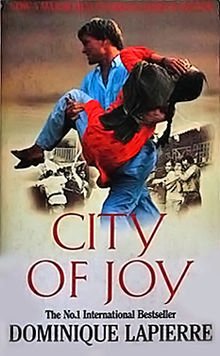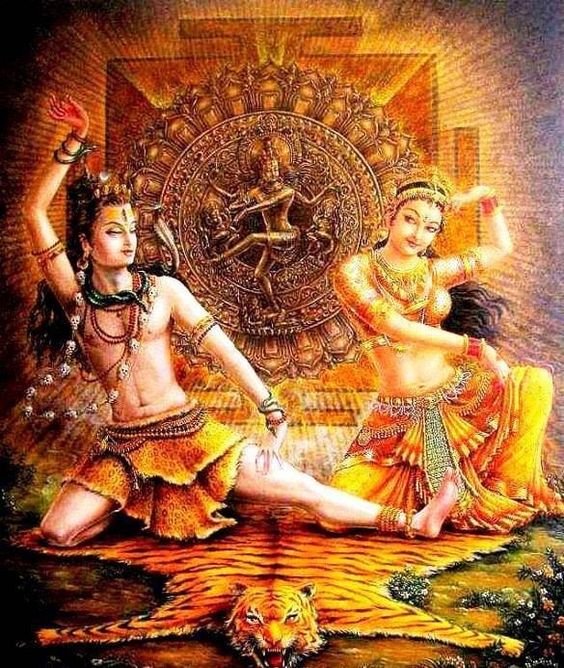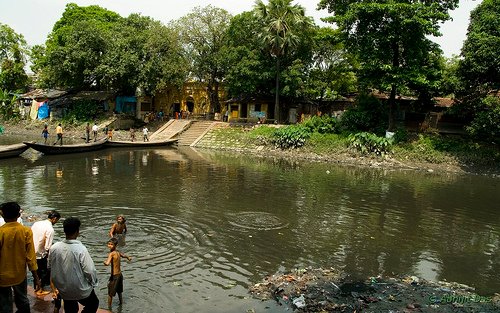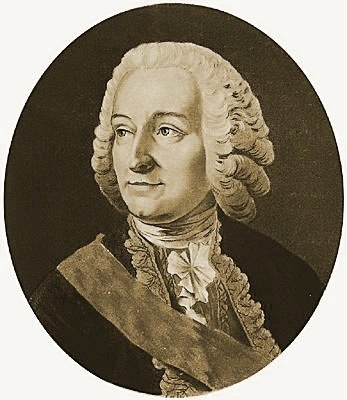The City of Joy
Kolkata is nicknamed the City of Joy after the eponymous novel by Dominique Lapierre, which Roland Joffé, in 1992 adapted into a film.

In the Pilkhana slum in Howrah, Kolkata, West Bengal, living in the most wretched of circumstances, named their slum "आनन्द नगर". City of Joy.

Modern Kolkata is home to the Kalighat, which houses a Kali shrine, bathing areas & the burning ghats or cremation grounds. North Calcutta hosts the Belur Math monastery & headquarters of the Ramakrishna Mission. Coupled with its concentration of Hindu priests, sadhus or Hindu holy men & doms or cremation ground workers. Kolkatta is the epicentre of all things Kali.
Inspite of 34 years of Communist rule till 2011, when the Trinamool Congress & Indian National Congress combine winning by a huge margin, Kali is alive & well in Kolkata.
The story of Kali, Kalikatta, Calcutta, Kolkata begins with the Adi Ganga, which today has degenerated into an open sewer channel of Kolkata.
Adi Ganga
The Adi Ganga is documented in medieval Bengali literature. Once-navigable, the Adi Ganga is now a strand of water laden with muck, toxins & waste.
Shiva, Sati & Parvati
According to the Puranas & Tantras Shiva's wife Sati killed herself after being insulted. Shiva wandered around the world in a mad dance around the world throwing the world into chaos.

Siva Sakthi : the performance of Tandava by Shiva, the dance of creation & destruction, or Birth & Death with the Lasya by Parvati Devi, the dance of happiness & joy.
In order to relieve him , the god Vishnu cut the goddess' body into 51 pieces with a sharp disc. They scattered all over the Indian sub-continent, & wherever they allegedly landed became sacred. According to the myth, her toe, in the form of Kali, landed in Bengal. The exact site was the bank of a strem coming off thr Hooghly river called Tolly's Nullah or in Bengali, the Adi Ganga.

Adi Ganga (Bengali: আদি গঙ্গা), also known as Gobindapur Creek, Surman’s Nullah and Tolly’s Nullah, was the main flow of the Hooghly River from the 15th to 17th century but has subsequently virtually dried up.
Adi Ganga
Kalikatta, Calcutta
A temple was built on the Adi Ganga's banks & a village with it named, Kalikata. As time went on, the worship of Kali/Durga became deeply rooted in this area. By the 15th century, the worship of Kali was well established in its present form. Kali worship expanded from Tollygunge, to Calcutta, to the wider Bengal, thus, cementing Bengal as the centre of Kali worship.
Kalikata, Kali cuts or hacks
Geoffrey Moorhouse, Calcutta, pg. 6, 1985, Holt, Richart & Wilson, New York

Job Charnock, the British East India Company agent, in 1690, visited a Hooghly River site to trade. A farmer misunderstanding Charnock's query about what the place was called replied in the Bengali idiom, "Kaal Kaata Hoyechhilo".
In 1689, Job Charnock of the East India Company chose this site for a great new trade city. Charnock anglicized Kalikata to Calcutta. Kolkata, as it is now called, was destined to become a powerful, world-influencing metropolis.
From 1772 to 1911, Calcutta was the capital of British India.
From 1912 to India's Independence in 1947, it was the capital the united Bengal.
After Independence, Calcutta remained the capital of the Indian state of West Bengal.
In Jan 2001, Calcutta was changed to Kolkata, as a part of a wholesale cleansing of
colonial influences.
A justification for this change is the belief Kolkata sounded like Kalikata,
one of three villages in this area where Kolkata is situated today, well before
the British period.
Another justification is the belief that the name Kalikata is derived from the
goddess Kali.
Kolkata
Over the years, this stronghold of Kali was transformed form an obscure jungle village into a strategic base of operations.
Was it only a bizzare myth that established Kali in this area?
Or was an ancient, demonic intelligence assembling the building blocks of a throne of darkness?
Why learn about Kali?
Lest Satan should get an advantage of us: for we are not ignorant of his devices.
2 Cor 2:11, KJV
Much of the modern church, has been ignorant of Kali's schemes. This article & those to follow are a brief description of Kali, a history of her workings & her devastating worldwide impact.
For though we walk in the flesh, we do not war after the flesh:
(For the weapons of our warfare are not carnal, but mighty through God
to the pulling down of strong holds;) 5Casting down imaginations, and
every high thing that exalteth itself against the knowledge of God, and
bringing into captivity every thought to the obedience of Christ;
And having in a readiness to revenge all disobedience,
when your obedience is fulfilled.
2 Cor 10:3-6, KJV
We're called to educate ourselves
My people are destroyed for lack of knowledge: because thou hast rejected knowledge,
I will also reject thee, that thou shalt be no priest to me: seeing thou hast forgotten
the law of thy God, I will also forget thy children.
Hos 4:6
We need not have any fear: the Son of Man did not use His Son of God override.
There is no fear in love [dread does not exist]. But perfect (complete, full-grown)
love drives out fear, because fear involves [the expectation of divine] punishment,
so the one who is afraid [of God’s judgment] is not perfected in love [has not grown
into a sufficient understanding of God’s love].
1 John 4:18 (AMP)
Such hope [in God’s promises] never disappoints us, because God’s love
has been abundantly poured out within our hearts through the Holy Spirit
who was given to us.
Romans 5:5 (AMP)
Further reading
Who is Kali?
Why was the Apostle Thomas murdered?
From Mongols to Mughals: How Kali came into great prominence in the Hindu pantheon
The Thugees: The world's first Mafia or The world's deadliest secet society?
Sacrificing children to please the gods
The Kali Series, Article 2.2
Based on Unmasking & Dethroning the goddess Kali by Jeshu Das, Calcutta, India
